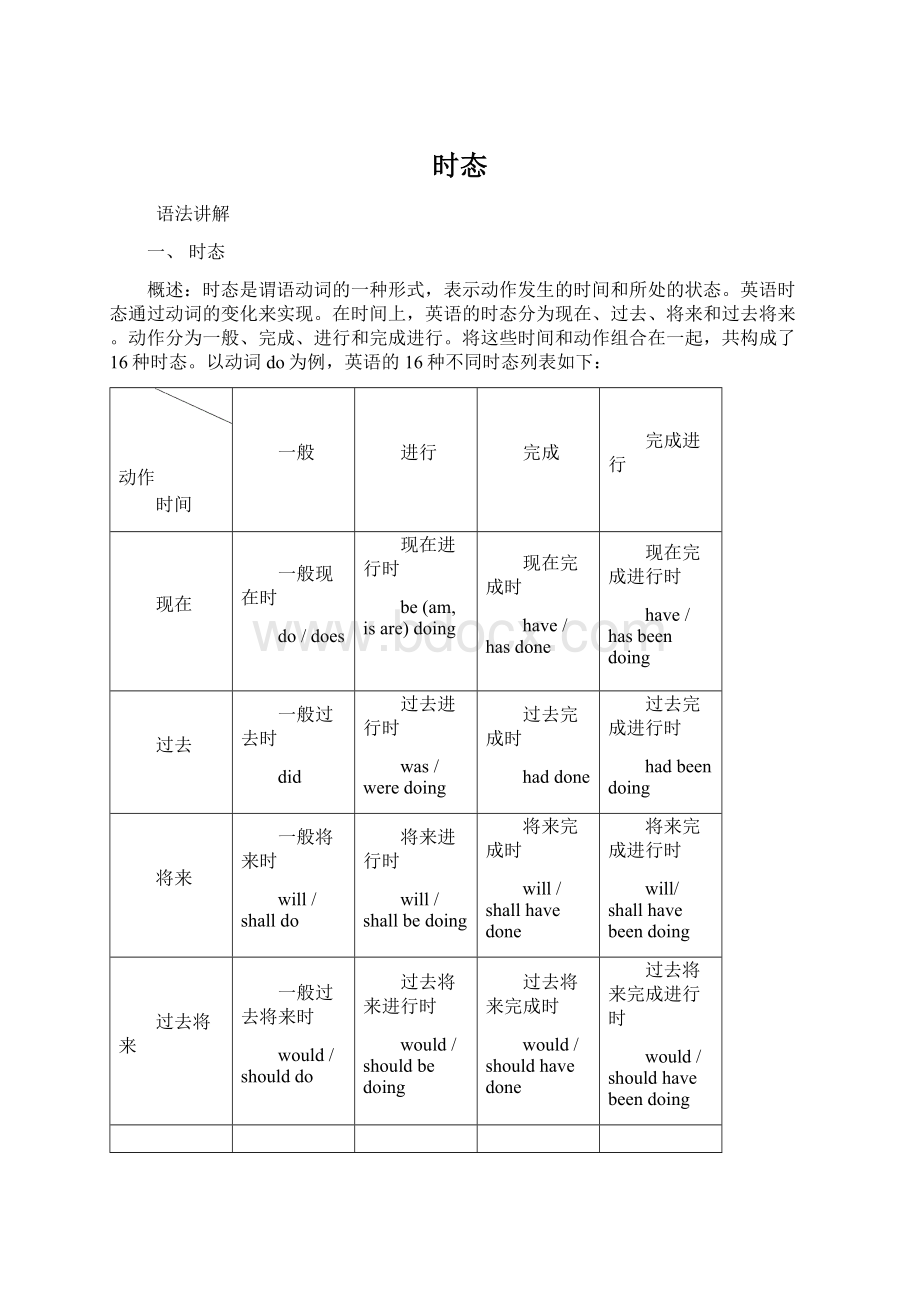时态.docx
《时态.docx》由会员分享,可在线阅读,更多相关《时态.docx(9页珍藏版)》请在冰豆网上搜索。

时态
语法讲解
一、时态
概述:
时态是谓语动词的一种形式,表示动作发生的时间和所处的状态。
英语时态通过动词的变化来实现。
在时间上,英语的时态分为现在、过去、将来和过去将来。
动作分为一般、完成、进行和完成进行。
将这些时间和动作组合在一起,共构成了16种时态。
以动词do为例,英语的16种不同时态列表如下:
动作
时间
一般
进行
完成
完成进行
现在
一般现在时
do/does
现在进行时
be(am,isare)doing
现在完成时
have/hasdone
现在完成进行时
have/hasbeendoing
过去
一般过去时
did
过去进行时
was/weredoing
过去完成时
haddone
过去完成进行时
hadbeendoing
将来
一般将来时
will/shalldo
将来进行时
will/shallbedoing
将来完成时
will/shallhavedone
将来完成进行时
will/shallhavebeendoing
过去将来
一般过去将来时
would/shoulddo
过去将来进行时
would/shouldbedoing
过去将来完成时
would/shouldhavedone
过去将来完成进行时
would/shouldhavebeendoing
1.一般现在时→do/does
A.定义
一般现在时表示现在经常反复发生的动作、存在的状态或习惯性的动作。
通常的时间状语有:
usually,often,sometimes,everymorning,always,nowandthen,occasionally,seldom,onSundays,atpresent,nowadays,thesedays,atthemoment,currently等。
B.一般用法
表示经常性或习惯性的动作;表示现在的特征、状态及能力;表示普遍真理或格言、警句。
Eg1:
Thearticlesuggeststhatwhenapersonunderunusualstressheshouldbeespeciallycarefultohaveawell-balanceddiet.
A.isB.wereC.beD.was
Eg2:
Theteachertoldthestudentsthattheearthroundthesun.
A.runB.runsC.ranD.wasrunning
C.特殊用法
(1)某些表示动作起止的动词,可用一般现在时表示一个按计划、规定、安排要发生的事,如begin,be,come,go,leave,arrive,return,stop,close,takeoff,meet,takeplace,happen等。
Eg3:
Whendoestheplanetakeoff?
(2)在时间状语从句、条件状语从句或让步状语从句中,用一般现在时代替一般将来时。
Eg4:
Ifitrainstomorrow,wewillputoffthesportsmeeting.
Evenifhedoesn’tcomethisSunday,I’llgofishingbymyself.
(3)特殊句型。
Eg5:
Itis/hasbeen5yearssinceImovedhere.
Eg6:
Ifshedoesn’ttellhimthetruthnow,he’llsimplykeeponaskingheruntilshe.
A.doesB.hasdoneC.willdoD.woulddo
D.真题呈现
Eg7:
IwillphoneyouassoonasIthenews.(B)
A.amgettingB.getC.willgetD.shallget
2.现在进行时→be(am,isare)doing
A.定义
现在进行时表示现在或现在这一阶段正在进行的动作。
常用的时间状语有:
now,atthemoment,thesedays,nowadays,atpresent等。
B.一般用法
说话时正在发生或正在进行的动作;现阶段正在进行而此刻不一定正在进行的动作。
Eg1:
Iamgivingalecture.
Iamreadinganovelthesedays.
Don’tdisturbhim.Heislisteningtotheweatherforecast.
C.特殊用法
(1)表示一个最近按计划或安排要进行的动作,限于表示来去、开始、结束、离开、到达等瞬间意义的动词。
Eg2:
WeareleavingonFriday.
(2)在时间状语从句、条件状语从句或让步状语从句中表达将来正在进行的动作。
Eg3:
Ifsheissleeping,don’twakeup.
(3)现在进行时与always,continually,constantly,allthetime等副词连用表示反复或习惯性的动作,含有某种感情色彩,如赞扬、遗憾、讨厌、不满等。
Eg4:
Heisalwayscominglate.
Youarealwaysthinkingofothers.
Mywifeisforevercriticizingme.
D.注意事项
(1)以下动词不宜用进行时:
表示心理状态、情感的动词如love,hate等;表示存在状态的动词如appear,exist,lie,be,have,belongto等;表示感官的动词如see,hear,notice,smell,taste,look等。
Eg5:
Thehousebelongstomyuncle.
(2)与一般现在时相比,现在进行时强调的是情况的暂时性,而非长期的习惯的动作或情况。
Eg6:
“Youveryclevertoday”,hismothersaidhappily.
A.arebeingB.havebeenC.wereD.are
译文:
“你今天真聪明。
”妈妈高兴地说。
--Youarebeingagoodgirltoday!
--今天你很乖哦!
Eg7:
Thefoodthatheiscookinginthekitchendelicious.
A.issmellingB.smellsC.hassmelledD.willsmell
E.真题呈现
Eg8:
Sendforadoctorquickly.Theoldman.(B)
A.willdieB.isdyingC.diesD.died
3.现在完成时→have/hasdone
A.定义
现在完成时表示动作在过去已经完成,但对现在仍有影响。
常用的时间状语有:
already,yet,before,just,ever,lately,recently,often,sometimes,never,once,twice,for…,since等。
B.一般用法
(1)不带时间状语的现在完成时表示说话之前动作已经完成,而后果和影响至今存在。
Eg1:
Thecityhastakenonanewlook.
(2)到现在为止这一时期中发生的情况(可能是多次动作的总和,也可表示状态和习惯性的动作。
Eg2:
Howmanypageshaveyoucoveredtoday?
Hehasbeenillforaweek.
(3)表示一直持续到现在的状态。
Eg3:
Themeetinghaslastedfivedays.
(4)在时间状语从句、条件状语从句或让步状语从句中表达将来某时已经完成的动作。
Eg4:
WhereyouhavelearnedEnglish,youwillfinditisabridgetomuchknowledge.
We’llstartatsixifithasstoppedrainingbythen.
C.特殊用法
(1)特殊句型
It’sthefirsttimethat…have/hasdone…
Ithasbeen/is+时间段+since…
Eg4:
It.isthefirsttimethatIhavebeentoBeijing.
IthasbeenfiveyearsthatIgraduatedfromthecolleg
(2)短暂性的动词的完成时不与时间段连用,如需连用可转化成相应的延续性动词,如:
die---bedead;leave---beaway;comeback---beback;
fallinlovewith---beinlovewith
marry---bemarriedtojoin---beamemberof=bein
Eg5:
Hehasdied.(×)
Hehasbeendeadfor3years.
D.典型例题
Eg6:
Italongtimesincewemetlast.
A.hasbeenB.willbeC.wasD.hadbeen
IamgladthatPeterdecidedtocometothepartybecausewe
Himforseveralyears.
A.don’tseeB.didn’tsee
C.hadn’tseenD.haven’tseen
D.真题呈现
Eg:
Theymoreenthusiasticabouttheirworksincetheirteacher’sreturn.(D)
A.areB.wereC.hadbeenD.havebeen
4.现在完成进行时→have/hasbeendoing
A.定义
B.一般用法
C.特殊用法
D.真题呈现
5.一般过去时→did
A.定义
B.一般用法
C.特殊用法
D.真题呈现
6.过去进行时→was/weredoing
A.定义
B.一般用法
C.特殊用法
D.真题呈现
7.过去完成时→haddone
A.定义
B.一般用法
C.特殊用法
D.真题呈现
Eg:
Ithereforfiveyearswhenthenewleadercame.(A)
A.hadworkedB.worked
C.wasworkingD.havebeenworking
8.过去完成进行时→hadbeendoing
A.定义
B.一般用法
C.特殊用法
D.真题呈现
Eg:
I
9.一般将来时→will/shalldo
A.定义
一般将来时,表示将来某一时刻的动作或状态,或将来某段时间内经常的动作或状态。
常用的时间状语有:
tomorrow,nextweek,fromnowon,inthefuture,in+时间段等。
B.一般用法
表示将来的动作或状态;表示将来经常发生的动作。
Eg1:
Hewillbebackinaweek.
Inafewyears’time,mostpeoplewillgotoworkbycar.
Eg2:
WhilepeoplemayprefertoTVforlatestnews,itisunlikelythatTVthenewspapercompletely.
A.replacedB.havereplaced
C.replaceD.willreplace
C.特殊用法
(1)一般将来时可用来表示一种倾向或习惯性动作。
Eg3:
Cropswilldiewithoutwater.
Wheneverhehastime,hewillcomeandseeme.
(2)其否定式won’t表示“不能…,没法…”。
Eg4:
Themachinewon’twork.
Thisplaywon’tact.
D.真题呈现
10.将来进行时→will/shallbedoing
A.定义
B.一般用法
C.特殊用法
D.真题呈现
11.将来完成时→will/shallhavedone
A.定义
B.一般用法
C.特殊用法
D.真题呈现
12.将来完成进行时→will/shallhavebeendoing
A.定义
B.一般用法
C.特殊用法
D.真题呈现
13.一般过去将来时→would/shoulddo
A.定义
B.一般用法
C.特殊用法
D.真题呈现
14.过去将来进行时→would/shouldbedoing
A.定义
B.一般用法
C.特殊用法
D.真题呈现
15.过去将来完成时→would/shouldhavedone
A.定义
B.一般用法
C.特殊用法
D.真题呈现
16.过去将来完成进行时
→would/shouldhavebeendoing
A.定义
B.一般用法
C.特殊用法
D.真题呈现